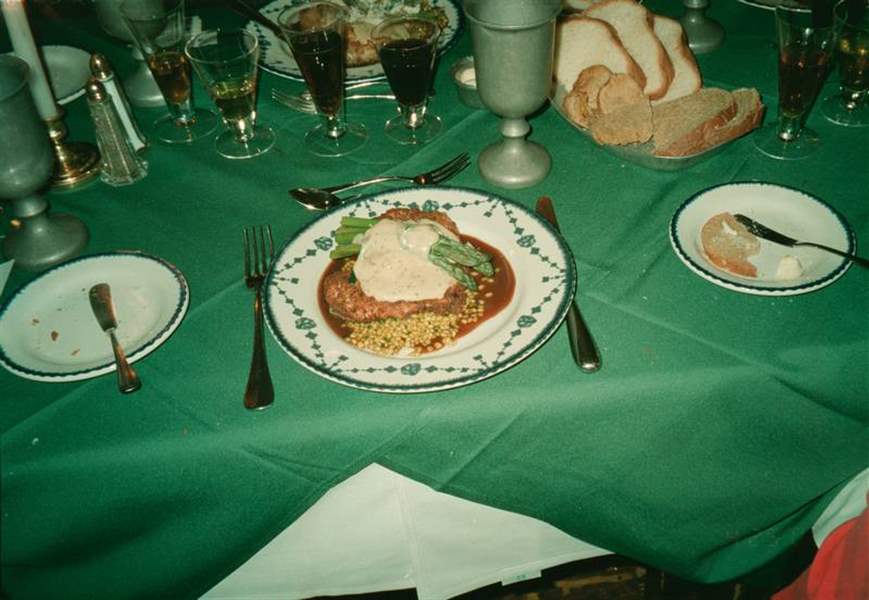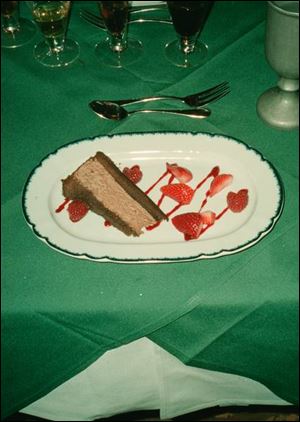
A taste of history: Colonial recipes fit for the Fourth
6/27/2006
Chicken in Porter Beer, Mount Vernon Style.

Chicken in Porter Beer, Mount Vernon Style.
PHILADELPHIA City Tavern in Philadelphia is an inspiration for any Fourth of July celebration. If you can t have lunch or dinner at one of the most historic restaurants in America, then cook a historic menu using recipes from chef-owner Walter Staib s cookbook.
You ll discover hearty recipes with a few unexpected ingredients. You ll also see how cooking has evolved in the last 230 years.
Chef Staib rescued the historic landmark when it captured my imagination, he writes in City Tavern Cookbook (Running Press, $29.95). City Tavern had been, without a doubt, the greatest restaurant in eighteenth-century North America. (See article below.)
With formal culinary training in Germany and more than 20 years in American restaurants, the German-born chef in the 1990s researched colonial culinary and dining traditions in order to re-create the culinary heritage of City Tavern.
He discovered how close to home 18th-century food was for him. He called it a window to the past at a dinner held for food journalists here in April during a seminar sponsored by the National Chicken Council and the U.S. Poultry & Egg Association.
Many of the dishes served on the four-course historic menu that was also sponsored by the National Beer Wholesalers Association were prepared and/or served with beers made exclusively for the restaurant.
Beer or ale was a common beverage in colonial times because there were few reliable sources of clean drinking water. Beer was safe to drink because of the brewing process, said Chef Staib. Everything was paired with beer.
He noted that George Washington made his own ale, but that it was 14 to 17 percent alcohol. We lowered the alcohol, he says of the beers made for the restaurant. Beer was used as a preservative, tenderizer, and as a flavoring agent.
Beer also played a role in the Revolutionary War. Soldiers were given beer to drink each day, according to the NBWA. A recipe for beer was found in one of George Washington s notebooks dated 1754. George Washington s Beer Recipe is in the cookbook.

A dessert inspired by Martha Washington is served at the City Tavern in Philadelphia.
Many early American cooks made their own sausage and their own beer. Both are lengthy processes for the modern cook.
At the dinner in April, first course was City Tavern s Ale-Braised Mallard Duck Sausage served with sweet and sour cabbage (at the restaurant, it is served with onions and often with potato dumplings and sauerkraut). If you can t find duck sausage, substitute kielbasa or any garlic-flavored pork sausage (except Italian-style). The recipe is made with a dark ale (City Tavern served it with Thomas Jefferson s 1774 Ale).
Colonial Philadelphia food reflected not only German flavors. West Indian cookery found its way into the fabric of Philadelphia life, writes the chef. Traditional Philadelphia Pepper Pot Soup, also in the cookbook and served as the second course, is made from an authentic West Indian recipe that is more than 250 years old. It dates to a time when English ships traveled through the islands transporting foodstuffs. The intense heat factor comes from Scotch bonnet peppers.
For the entree, the restaurant re-created a beer from Benjamin Franklin called Blue Spruce that fermented into ale. It was used to flavor the Chicken in Porter Beer, Mount Vernon Style accompanied by Asparagus and Herbed Barley. The recipe was made especially for a dinner to celebrate Benjamin Franklin s 300th birthday on Jan. 17, the chef said in a phone interview.
Chicken served with crab is a colonial custom, explained Kelly Melendez, special events coordinator for City Tavern, who was involved with the planning of the historic menu in April. During colonial times, crab was very plentiful.
The chicken is seasoned and marinated, then dredged in flour, dipped in egg, and coated with bread crumbs before sauteing. It is served with lumb crabmeat and Bernaise sauce, made from scratch at the restaurant (to simplify, use an instant mix at home).
Herbed barley is one of the oldest cultivated grains. It was a staple crop in colonial times and was filling and hearty enough to act as a main course. Other colonial starches were potatoes, German spaetzle or egg noodles, grains such as barley and rice or freshly baked bread. Meat was expensive and not consumed by the average family except for special occasions.
For dessert, Martha Washington s Chocolate Mousse Cake recipe from City Tavern Cookbook was served. It is based on the original slightly sweeter version that was Martha Washington s favorite. Chocolate was first mentioned in recipes as early as 1675, but its use in baking and as a hot drink goes back to Columbus, who brought cocoa beans to Spain.
Thomas Jefferson first tasted chocolate in France and believed it was healthier than drinking coffee or tea, writes the chef.
The cookbook author also notes that eggs in this recipe are only partially cooked, which may present a health concern for the young, the elderly, or those whose immune systems are compromised.
To avoid any potential health problems, The Blade tested the recipe with pasteurized eggs, which cost only a few cents more than regular eggs. We found them under the Davidson s brand with the P stamped on each egg to indicate pasteurization.
We also found that the cake batter amply filled 9-inch layer cake pans with some batter left over. So we suggest using 10-inch layer cakes or filling 9-inch layer cakes two-thirds full and then baking the remaining batter for cupcakes or a small cake for another use.
It s common to have to adjust historic recipes as the ingredients, techniques, and equipment have changed over the years.
Kathie Smith is The Blade s food editor.
Contact her at: food@theblade.com or 419-724-6155.